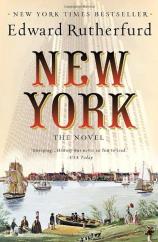New York: The Novel
Review
New York: The Novel
Edward Rutherfurd, whose sweeping historical epics introduced us
to 10,000 years of ancient SARUM and thousands of years of LONDON,
now turns his historical pen to that young upstart of the west ---
New York City.
One of the greatest cities of the world, New York City saw its
humble beginnings in a tiny Indian fishing village in the forests
of Manhattan in the mid-1650s. The ancient cities of Europe and the
Orient had flourished for thousands of years before the rustic
trading center in New Amsterdam began to bustle with ships sailing
across the Atlantic into its natural harbor.
In this history, the Master family, descended from the earliest
traders, is followed through many generations and historical events
in NEW YORK: THE NOVEL. They and their families are portrayed in
this epic saga covering the great events that shaped our new
nation. Rutherfurd explores the Revolutionary War, the Civil War,
the numerous stock market crashes, the racial divides that occurred
as each new wave of ethnic immigrants swept ashore to start new
lives in the promised land. We’ve read of these historical
events in some of our country’s greatest literature, but
Rutherfurd’s take on our history is seen through the eyes and
experiences of New Yorkers, who were often not as closely involved
as one might assume.
Many might be surprised to learn that in the 1760s and 1770s,
New York’s role in the American Revolution was neutral. New
York at first abstained from signing the Declaration of
Independence and stayed at arm’s length from the war until
British ships were almost in New York Harbor. We learn that this is
because the majority of influential New Yorkers were royalists who
regarded the upstart revolutionaries of Boston and Philadelphia as
rabble rousers who should at the very least be ignored, if not
hanged for treason. The Revolutionary War was an annoyance to New
Yorkers that interfered with trade and the booming commerce that
would come to define the city.
The Civil War was also viewed from afar. The lucrative slave
trade that sustained the trading routes of the Dutch West India
Company --- and the many others that developed in the first 150
years --- was jeopardized by the threatening secession from the
Union by the South. From its very beginnings, New York was
about banking and making money. Unlike the industrial South and the
growing inland cities, it did not manufacture goods; it marketed
them. It did not grow crops; it traded them and invested the
profits on Wall Street. If patriotism stirred the early New Yorker,
it was about profit; it tended to leave the flag waving and
fighting to the rest of the country. Street demonstrations in later
years were more apt to be about suffrage, prohibition and social
causes than about taking up arms in civil and international
wars.
The early slave holders in the Master family gradually change to
more progressive thinking, but are still torn --- even as slavery
is abolished --- to holding to the old ways. The family encounters
the forces of Tammany Hall, the Irish (and later, the Italian)
mobs, the Jewish artists and craftsmen, and the Asian communities
that gradually move in as other ethnic groups move out. New York
evolves before our very eyes as some of the great landmarks rise,
then fall to fire, dilapidation, or new development. Overhead
railways change to subways, and narrow streets turn into freeways
and parkways. The city crawls slowly northward, filling up as waves
of ethnic groups move in behind other ethnic groups who want to
move up or out. Anyone who has visited New York City in the last
half century has watched this evolution as familiar buildings and
landmarks vanish from the skyline, the most regrettable being the
World Trade Center.
As the progeny of immigrants during different times in
America’s history, it is fascinating for me to read in such
vivid detail about the times in which our ancestors lived.
Rutherfurd is a master at bringing to life the people and streets
of the times, not just the events. By happenstance, many of
the eras he describes coincide with my own family history. To enjoy
his almost cinematic description of New Amsterdam in the mid-1600s
when my too-many-greats-to-be-listed grandfather was a clerk from
Delft, Netherlands for the Dutch West India Company and then opened
a bar on Beaver Street, which could have been the same tavern
mentioned in the book, sent chills up my spine. A later branch on
my family tree when my great-grandmother arrived from Ireland in
1860 coincided with the upheaval prior to the Civil War.
But no matter if you are Dutch, English, descendents of slaves,
Italian, Asian, Jewish, German, or Nordic, there were so many
important events that affected the people on the streets that one
can’t help but feel a bit of déjà vu if you are
lucky enough to have had older relatives who reminisced about times
past. And it’s all there: the book starts with the Indians
and traders in New Amsterdam and ends in 2009. Three hundred and
seventy years is a mere blink of an eye in historical terms, but
what a history it is.
Reviewed by Roz Shea on January 12, 2011
New York: The Novel
- Publication Date: January 12, 2011
- Genres: Fiction, Historical Fiction
- Paperback: 880 pages
- Publisher: Ballantine Books
- ISBN-10: 0345497422
- ISBN-13: 9780345497420




